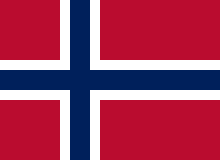Norway–Sweden relations
 | |
Norway |
Sweden |
|---|---|
| Diplomatic mission | |
| Embassy of Norway in Stockholm | Embassy of Sweden in Oslo |
| Envoy | |
| Ambassador Anne K. Lund | Ambassador Axel Wernhof |
Sweden has an embassy in Oslo and 14 consulates, in Ålesund, Arendal, Bergen, Bodø, Hamar, Hammerfest, Kirkenes, Mandal, Moss, Narvik, Porsgrunn, Stavanger, Tromsø and Trondheim.[1] Norway has an embassy in Stockholm and three consulates, in Gothenburg, Malmö and Sundsvall.
Both countries are full members of the Council of Europe, Nordic Council and NATO. There are around 44,773 Swedes living in Norway[2] and 41,062 Norwegians living in Sweden.[3]
Country comparison
| Official Name | Kingdom of Sweden | Kingdom of Norway |
|---|---|---|
| Common Name | Sweden | Norway |
| Flag | 
|

|
| Coat of Arms |  |
 |
Royal Anthem
|
Kungssången
(English: "Song of the King") |
Kongesangen
(English: "King's Song") |
| Population | 10,481,937 | 5,425,270 |
| Area | 447,452 km2 | 385,207 km2 |
Population Density
|
25/km2 | 14.0/km2 |
| Capital
|
Stockholm | Oslo |
| Government | Unitary parliamentary constitutional monarchy | Unitary parliamentary constitutional monarchy |
| Legislature | Riksdag | Storting |
| First Leader | Charles XIV John | Haakon VII of Norway
|
| Current Leader | Carl XVI Gustaf (Monarch)
Ulf Kristersson (Prime Minister) |
Harald V (Monarch)
Jonas Gahr Støre (Prime Minister) |
| Main Language | Swedish | Norwegian |
| Main Religions |
58.9% Christianity
|
71% Christianity
|
| GDP (nominal) | US$599 billion | $522 billion |
| GDP (nominal) per capita | US$55,395 | $92,646 |
| GDP (PPP) | US$712 billion | $425 billion |
| GDP (PPP) per capita | US$65,842 | $64,363 |
| Real GDP Growth Rate | -0.5% | 1.6% |
| HDI | 0.947 | 0.961 |
| Military Expenditure | 1.09% of GDP | 1.4% of GDP |
| Military | Swedish Armed Forces | Norwegian Armed Forces |
| Military Personnel | 50,950 | 63,250 |
| Labour Force | 5,107,000 | 2,707,000 |
International border
Crossing the border between Sweden and Norway is relatively simple. No passport is required due to the Nordic Passport Union and there are no physical border obstructions. However, since Norway is not part of the European Union customs controls can be made if traveling by car to prohibit smuggling. Foreign citizens requiring visa to either state are not allowed to cross the border legally without applying for visa again. There are no restrictions on non-felon Swedish and Norwegian people's rights to live in the neighbouring country.
-
Embassy of Norway, Stockholm
European Union
Sweden joined the EU in 1995. Norway has never been a member of the EU.
NATO
While Norway was one of the founding members of NATO, Sweden has only been a member since 2024. In 2023, Sweden and Finland both sought membership as a consequence of the Russian invasion of Ukraine. While Finland's entry took place mid-2023, Sweden's entry was prolonged by multiple hurdles[4] but was finally approved early 2024 and officially joined on March 7, 2024.[5]
See also
- Foreign relations of Norway
- Foreign relations of Sweden
- Union between Sweden and Norway
- Norwegian Swedes
- Swedes in Norway
- Sweden–NATO relations
- Denmark–Sweden relations
References
- ^ "Norway". Regeringskansliet. Retrieved 2010-02-10.
- ^ Statistics Norway
- ^ https://www.scb.se/hitta-statistik/statistik-efter-amne/befolkning/befolkningens-sammansattning/befolkningsstatistik/pong/tabell-och-diagram/helarsstatistik--riket/folkmangd-efter-fodelseland-19002020/ [dead link]
- ^ "Sweden–NATO relations", Wikipedia, 2024-03-03, retrieved 2024-03-03
- ^ Berlinger, Joshua (2024-02-26). "Sweden clears final hurdle in bid to join NATO after Hungary approves accession". CNN. Retrieved 2024-03-22.




